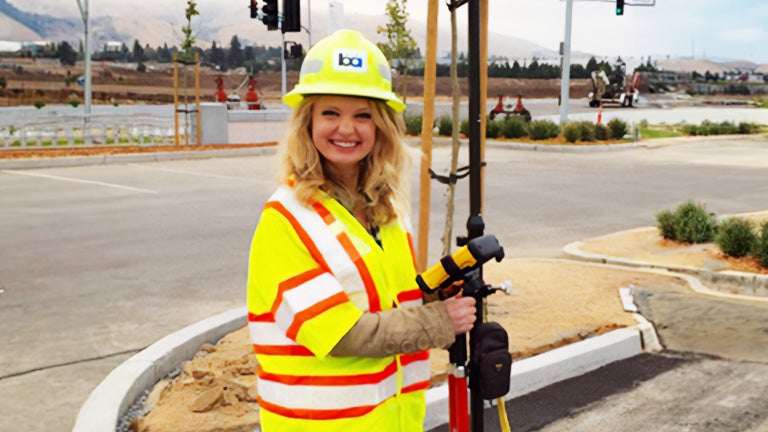“As I finish my graduate degree, I am currently looking for various jobs at the intersection of GIS and sustainability.
I know that the skills I gained at the Spatial Sciences Institute will be essential in whatever place I settle. With potential applications in local government and sustainability planning, energy and natural resources, infrastructure and business analytics, the minor in Spatial Studies has opened the door to many potential sectors I had not previously considered.”
Jackson FitzGerald, B.A. Archaeology, B.S. Environmental Studies, Spatial Studies Minor ’22; Student, Master of Philosophy, Archaeological Science, University of Cambridge

Conduct and present research
Spatial Studies minors are eligible to join the research teams of the world-class faculty appointed in and affiliated with the USC Spatial Sciences Institute.
In the studio, lab or field, our minors have contributed to award-winning research results. They have presented their teams’ findings at symposia and conferences such as the annual meeting of the
American Association of Geographers, the US Geospatial Intelligence Foundation GEOINT Symposium, the Los Angeles Geospatial Summit and the Esri User Conference.
Meet some alumni and students with a Spatial Studies minor

Sarah Ellis, B.S. Policy, Planning and Development, Spatial Studies Minor ’14, Graduate Certificate in GIST ’15, M.S. GIST ’18
Right after graduating USC in May 2015 with a major in Policy, Planning, and Development and a minor in Spatial Studies, I started a job as a contracted GIS Technician for Apple engineering teams. I worked with spatial data providing technical services, assessing, validating and enhancing world location data content for consumer applications and metrics.
While working with Apple, I obtained the USC GIST online graduate certificate, but I was still looking for greater opportunities, more related to my passion for urban planning.
With the graduate certificate on my resume, I quickly received another offer to join the Enterprise GIS team at San Francisco Bay Area Rapid Transit (BART) as a contractor, and then as a consultant. Even though there are only two Principal GIS Analysts and me, BART’s GIS repertoire is renown, winning multiple Esri achievement awards. In my first couple of weeks, I attending training for Schnieder Electric’s ArcFM extension for fiber optic network.
I was the primary implementation and management specialist for BART’s over 13 million feet of fiber optic cable connecting major transportation and telecommunication companies throughout the Bay Area. I also help out with various cartography related tasks for the construction teams, planners, IT department, police department and other departments within the larger transit agency, as well as data clean-up and asset feature data updates to ensure our data integrity, and heads-up digitizing.
I have learned so much while I was with BART, and recently decided to finish my USC M.S. in GIST degree. Since I now have a focus and a bit of a specialization, it is much easier to choose a relevant thesis and choose classes based on my career goals. Being a part of BART is such a great opportunity that I never would have gotten without USC’s stellar reputation and the heavy emphasis on the ArcGIS suite.
Now I am the Senior GIS Technician for the City of Vancouver, Washington. My USC education has given me the tools to learn on the job and become an expert in a field I never would have guessed.

Monica Finnstrom, B.S. Environmental Science and Health; Spatial Studies Minor ’18; M.S. in Geographic Information Science and Technology ’19
Spatial Studies offers the unique opportunity of bringing new insights to many different fields of study by applying spatial thinking. My interest in GIS stemmed from taking classes with the Spatial Sciences Institute, where I immediately became fascinated by its practicality and wide-spread application. As an Environmental Science and Health major, I found the Spatial Studies minor to be the perfect complement to my course of study. This minor allowed me to go beyond acquiring knowledge and provided an essential technical skillset within environmental applications.
Through the minor, I have had the opportunity to work with the Spatial Sciences Institute as an undergraduate researcher with Dr. Su Jin Lee and fellow students for two years. During my first year of research, I was able to use spatial thinking for an environmental project analyzing the spatial patterns of air pollution and different contributing factors in Los Angeles County. For my second year of research, I participated in a study looking at how municipal policies affect tree cover within the 30 largest cities in Los Angeles County. These research opportunities have provided me with valuable experience and have cultivated my interest in GIS.
I continued my GIS journey by obtaining the USC M.S. in Geographic Information Science and Technology through the Progressive Degree Program.
Now I am working as Senior Specialist, Global Security Communications Center at The Walt Disney Company in Burbank, California.

Jackson FitzGerald, B.A. Archaeology, B.S. Environmental Studies, Spatial Studies Minor ’22; Student, Master of Philosophy, Archaeological Science, University of Cambridge
Spatial sciences formed an important part of my time at USC and will always influence the way that I think about the world around me.
The Spatial Studies minor, particularly the knowledge of GIS, was the perfect addition to round out my education alongside my Environmental Studies and Archaeology degrees for its practicality and its insights.
Beyond the classroom, my most formative experiences were working as a student researcher within the Spatial Sciences Institute. My sophomore year, I had the opportunity to be a Geodesign Fellow which was the first time the skills I learned during courses was applied to the real world problems of infrastructure and sustainability. Over the rest of my time at USC, I was a part of the Urban Trees Initiative, where we leveraged GIS to better understand canopy conditions across Los Angeles.
These experiences, alongside my coursework, even allowed me to become a Solution Engineer intern at Esri the summer after I graduated in large part due to the large number of ArcGIS products I became familiar with.
Since graduating, GIS has been a key part of my thesis research for my master’s of Archaeological Science at the University of Cambridge. By building a strong foundation of GIS analysis at USC, I was able to focus on the archaeological, scientific, and statistical aspects of the project. As I finish my graduate degree, I am currently looking for various jobs at the intersection of GIS and sustainability.
I know that the skills I gained at the Spatial Sciences Institute will be essential in whatever place I settle. With potential applications in local government and sustainability planning, energy and natural resources, infrastructure and business analytics, the minor in Spatial Studies has opened the door to many potential sectors I had not previously considered.
Learning objectives
- Learn how geographically referenced data can be gathered and organized to support a large number and variety of collaborative projects.
- Learn how to perform spatial analysis and modeling to create new knowledge across a variety of disciplines and application domains.
- Learn how to make maps that synthesize and communicate new knowledge about places and people.

CURRICULUM
4 units of lower-division elective (choose one below):
-
Major culture types, nomadic hunters and herders, peasant and tribal societies, sophisticated kingdoms; social, political, economic, and religious institutions.
-
Archaeology as the means of investigating our shared human past, from the origins of humanity to the foundations of current civilization.
-
Visual communication techniques applicable to the design of the built environment; drawing, photography, modeling.
-
Introduction to the ways architecture represents aspirations of culture, satisfies practical and spiritual needs, shapes the social and urban environment, and helps preserve the planet.
-
An examination of the physical and biological laws that influence agriculture, pollution, population dynamics (including humans), climate, biodiversity and ecosystem structure and function
-
Methods and techniques employed in modern archaeological research, including the tools and principles of allied scientific fields and the impact of analytical and technological advances.
-
Impact of civilization on planet earth, and impact of earth’s natural evolution on society: earthquakes, volcanism, landslides, floods, global warming, acid rain, groundwater depletion and pollution; mineral and fossil fuel depletion, formation of the ozone hole.
-
Climate systems from the beginning of earth history to the present; tools and techniques used to reconstruct prehistoric climate records; effects of climate variations on development of life forms on earth.
-
A thematic approach to California history from precontact to present; focus on peoples, environment, economic, social, and cultural development, politics, and rise to global influence.
-
The urban context for planning and policy decisions. Socioeconomic, physical, and spatial structure of cities: and the underlying demographic, economic, and social processes that drive their ongoing transformation.
-
Examination of the challenges of environmental problem-solving at the personal, local, national and global scales, focused on the issue of climate change.
-
Los Angeles as a metaphor for the American Dream, exploring the city’s history and potential futures, including economic opportunity, social justice, spatial organization, and environmental sustainability.
-
Los Angeles as a metaphor for the American Dream, exploring the city’s history and potential futures, including economic opportunity, social justice, spatial organization, and environmental sustainability.
-
The influence of sustainability science on public policy and vice versa in the context of social/ethical theories, analytical methods and solutions.
-
Introduction to the complex relationship between human development and natural hazards, which are increasingly causing damage and displacement to human populations throughout the world.
-
An exploration of earth’s water, ranging from water properties, chemistry, and pollution, to groundwater dynamics, watershed processes, and oceanic-atmospheric circulation. Implications for past and future societies.
3 required courses (12 units)
-
Role of maps and spatial reasoning in the production and use of geographic information for representing and analyzing human and environmental activities and events.
-
The various ways in which geography can be used to acquire, represent, organize, analyze, model and visualize information. Laboratories are organized around ArcGIS software suite. Recommended preparation: SSCI 301L.
-
Fundamentals of spatial modeling and remote sensing and how to use GIS customization and programming to streamline complex spatial analysis and modeling workflows. Prerequisite: SSCI 382L.
4 units of upper-division elective (choose one below)
-
Training of archaeology students in the use of GIS through the understanding of basic principles and theoretical restrictions of geospatial sciences.
-
Critical observation of the architecture of public buildings and places and the importance of design in promoting a better contemporary public life.
-
Emphasis on photographic storytelling in print, video and Web-based media; understanding of visual thinking and imagery techniques.
-
Introduction to graphic design, photodocumentation, and geographic information systems as employed in planning, policy, and development. Visual explanations. Computer and by-hand applications.
-
Basic GIS concepts, ArcView and other GIS software, planning applications and databases, basic cartography; students select, research and prepare a planning GIS analysis project.
-
Students examine images of urban America and use the camera to produce visual representation in their analysis of social relations.
-
Conceptual foundations and techniques of statistics and how they can be used with geographic data to produce actionable information across spatial science domains.
-
Intensive experience in local public agency, private firm, or nonprofit agency engaged in applied geospatial analysis, modeling and mapping work. Graded CR/NC.
Learn more
Ask Dr. Diana Ter-Ghazaryan about the minor in Spatial Studies. Email her at lterghaza@usc.edu.





